The MADGRAPH system (1977-1979)
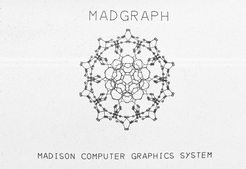 In 1977 John McAlister and I were graduate students in the lab
of M Sundaralingam at the University of Wisconsin, Madison.
Sunda could not find money to buy a state-of-the-art
graphics system from Evans and Sutherland, so instead he
had purchased a Vector General. It was a rather fancy
VG, however, and shared memory with
the host computer, a
PDP-11/35.
We were very proud of
the fact that our PDP could do floating point math in
hardware, and that it had 5 MBytes of disk space!
Unfortunately, at that time there was not a general purpose
molecular graphics package available for this hardware,
so John and I spent a year or two writing one.
These screen shots were taken for a talk I gave at the 1979
ACA meeting in Boston describing the MADGRAPH molecular
graphics system.
In 1977 John McAlister and I were graduate students in the lab
of M Sundaralingam at the University of Wisconsin, Madison.
Sunda could not find money to buy a state-of-the-art
graphics system from Evans and Sutherland, so instead he
had purchased a Vector General. It was a rather fancy
VG, however, and shared memory with
the host computer, a
PDP-11/35.
We were very proud of
the fact that our PDP could do floating point math in
hardware, and that it had 5 MBytes of disk space!
Unfortunately, at that time there was not a general purpose
molecular graphics package available for this hardware,
so John and I spent a year or two writing one.
These screen shots were taken for a talk I gave at the 1979
ACA meeting in Boston describing the MADGRAPH molecular
graphics system.
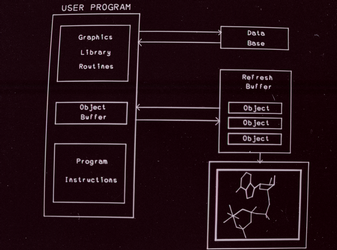 The pictures were shot from the VG screen using a 35mm
camera loaded with black-and-white film. The negatives were
mounted for direct projection, yielding a black on white
image as shown above in the title slide for the MADGRAPH talk.
I have inverted the colors of the other images after
scanning them in, so that they give a better idea of what
the VG screen itself looked like.
These negatives were scanned in 2002 after sitting for
25 years in a binder on my bookshelf, and they are somewhat
the worse for it.
The distortion you see in the shots below is due mostly to
the camera lens, but also due in part to the nature of the
vector display tube.
The pictures were shot from the VG screen using a 35mm
camera loaded with black-and-white film. The negatives were
mounted for direct projection, yielding a black on white
image as shown above in the title slide for the MADGRAPH talk.
I have inverted the colors of the other images after
scanning them in, so that they give a better idea of what
the VG screen itself looked like.
These negatives were scanned in 2002 after sitting for
25 years in a binder on my bookshelf, and they are somewhat
the worse for it.
The distortion you see in the shots below is due mostly to
the camera lens, but also due in part to the nature of the
vector display tube.
The Vector General had a calligraphic display,
which means that it drew each line segment of the figure one by one,
deflecting the electron gun to trace out each segment in succession.
The more line segments to be displayed, the longer it took to refresh the
display screen - so complicated images had a tendency to flicker.
You had to build up the image to be displayed from hardware-supported
primitive objects consisting of lines, circles, arcs, and alphanumerics.
The MADGRAPH machine was a VG series 3 (DEC3R), which had
a special bank of memory called a refresh buffer that was shared with
the host computer. The VG had hardware to apply a rotation/translation
matrix to objects as they were displayed, but in order to nest levels
of rotation (as in torsional rotation about a bond) or to change the
overall viewing angle required intervention by the host CPU.
That meant that the bulk of the graphics manipulation was done by
a driver layer running on the host computer, analogous to the
operation of a cheap "winmodem" or "winprinter" in today's PC world
in which processor cycles are stolen from the host CPU to supplement
a minimal hardware implementation.
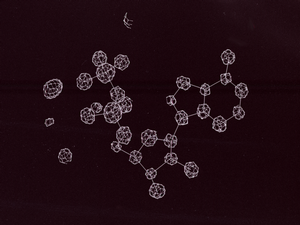
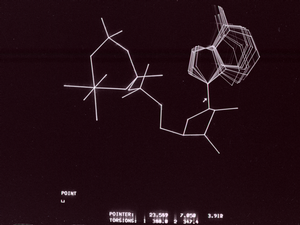
The MADGRAPH software could display crystallographic models and electron
density maps. It allowed for atom selection and torsion
angle rotation. It was never fully developed for work with
protein structures, however, because Sunda's laboratory was
at the time focused on tRNA and on small molecule work with
analogues and complexes of nucleic acids.
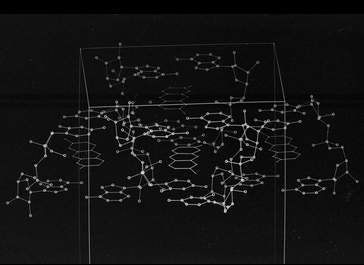
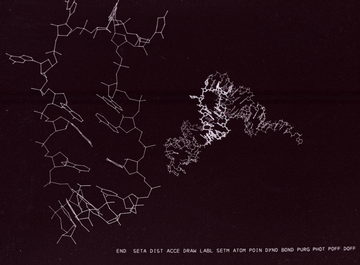
Vector General hardware sank into history without a trace,
the 8-track tape of molecular graphics.
MADGRAPH lost out to Alwyn Jones' program Frodo, which was
developed on similar hardware at roughly the same time but
was soon ported to the more capable display systems sold by
Evans and Sutherland.
MADGRAPH's steamboat logo
lived on for a while in some of the programs
John McAlister later developed for TRIPOS.
more screen shots
Ethan A Merritt - April 2002
 In 1977 John McAlister and I were graduate students in the lab
of M Sundaralingam at the University of Wisconsin, Madison.
Sunda could not find money to buy a state-of-the-art
graphics system from Evans and Sutherland, so instead he
had purchased a Vector General. It was a rather fancy
VG, however, and shared memory with
the host computer, a
PDP-11/35.
We were very proud of
the fact that our PDP could do floating point math in
hardware, and that it had 5 MBytes of disk space!
Unfortunately, at that time there was not a general purpose
molecular graphics package available for this hardware,
so John and I spent a year or two writing one.
These screen shots were taken for a talk I gave at the 1979
ACA meeting in Boston describing the MADGRAPH molecular
graphics system.
In 1977 John McAlister and I were graduate students in the lab
of M Sundaralingam at the University of Wisconsin, Madison.
Sunda could not find money to buy a state-of-the-art
graphics system from Evans and Sutherland, so instead he
had purchased a Vector General. It was a rather fancy
VG, however, and shared memory with
the host computer, a
PDP-11/35.
We were very proud of
the fact that our PDP could do floating point math in
hardware, and that it had 5 MBytes of disk space!
Unfortunately, at that time there was not a general purpose
molecular graphics package available for this hardware,
so John and I spent a year or two writing one.
These screen shots were taken for a talk I gave at the 1979
ACA meeting in Boston describing the MADGRAPH molecular
graphics system.
 The pictures were shot from the VG screen using a 35mm
camera loaded with black-and-white film. The negatives were
mounted for direct projection, yielding a black on white
image as shown above in the title slide for the MADGRAPH talk.
I have inverted the colors of the other images after
scanning them in, so that they give a better idea of what
the VG screen itself looked like.
These negatives were scanned in 2002 after sitting for
25 years in a binder on my bookshelf, and they are somewhat
the worse for it.
The distortion you see in the shots below is due mostly to
the camera lens, but also due in part to the nature of the
vector display tube.
The pictures were shot from the VG screen using a 35mm
camera loaded with black-and-white film. The negatives were
mounted for direct projection, yielding a black on white
image as shown above in the title slide for the MADGRAPH talk.
I have inverted the colors of the other images after
scanning them in, so that they give a better idea of what
the VG screen itself looked like.
These negatives were scanned in 2002 after sitting for
25 years in a binder on my bookshelf, and they are somewhat
the worse for it.
The distortion you see in the shots below is due mostly to
the camera lens, but also due in part to the nature of the
vector display tube.



